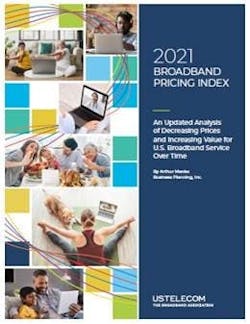As Congress begins to debate broadband infrastructure and connectivity policy, USTelecom – The Broadband Association this week released its 2021 Broadband Pricing Index (BPI), new research showing the decreasing cost and increasing value of broadband service in the United States between 2020 and 2021.
Using FCC and other public data, the 2021 BPI research examines recent trends in residential fixed broadband pricing in the United States. According to the trade group, this second installment of the BPI study "reveals continued and substantial price reductions for the most popular and highest-speed broadband internet services. These price declines coincide with an unprecedented increase in pandemic-related broadband demand and an increase in the overall cost of consumer goods," added a USTelecom statement.
Jonathan Spalter, president and CEO of USTelecom, commented: “These findings are relevant to the current debate surrounding broadband affordability. In a year when everything seemed to be going up – consumers used broadband connectivity as never before, while the cost of goods and services increased too – the price of broadband went in the opposite direction. This continues a years-long story of declining prices, not to mention accelerating speeds that have unlocked a range of broadband-fueled innovations. The truth is, more Americans have cheaper and flat-out better broadband service choices than they did one year ago.”
2021 Broadband Pricing Index (BPI) Key Findings
According to USTelecom, the BPI analysis makes price comparisons on two fronts: the most popular speed tiers (BPI-Consumer Choice) and the highest speed tiers (BPI-Speed), and found substantial broadband price reductions have occurred in year-over-year (YOY) comparisons for the pandemic years of 2020 and 2021.
Key findings are as follows:
- The price of the most popular tier of broadband service has declined by 7.5 percent year YOY; a one-year price decline of 9.3 percent when adjusted for inflation.
- The price for the highest speed broadband service offering declined by 2.3 percent YOY; a one-year price decline of 4.2 percent when adjusted for inflation.
- These broadband price declines (from 2020-2021) occurred at a time when the cost of overall goods and services increased by 1.9 percent.
Declining barriers to broadband adoption, targeted affordability policy necessary
As stated by USTelecom:
The surge in broadband usage during the pandemic demonstrated our national dependence on broadband. While a broadband connection has become nearly indispensable to modern life, not all Americans have a broadband connection. For some, this is because connections are not available in their neighborhood. For others, a high-quality fixed broadband connection may be unaffordable.
This research demonstrates the significant and continuing downward trend in broadband prices that is causing affordability as a barrier to broadband adoption to recede; it also supports a national policy that targets federal connectivity assistance to low-income Americans to close the digital divide.
USTelecom's Spalter added: “Should our nation now strive for universal broadband connectivity? Absolutely. Should we do so by upending the policies that have made our innovation economy – and our broadband networks which fuel it – the envy of the world and sparked investment that has connected 90%+ of the U.S. population? No way. Our primary and targeted focus now must be ensuring all our fellow citizens are able to connect.”
The 2021 Broadband Pricing Index findings also bolster USTelecom’s recent study, US vs. EU Broadband Trends (2012-2019), research showing the United States leads the European Union in broadband deployment and adoption, while offering superior service powered by three times the investment in infrastructure.
